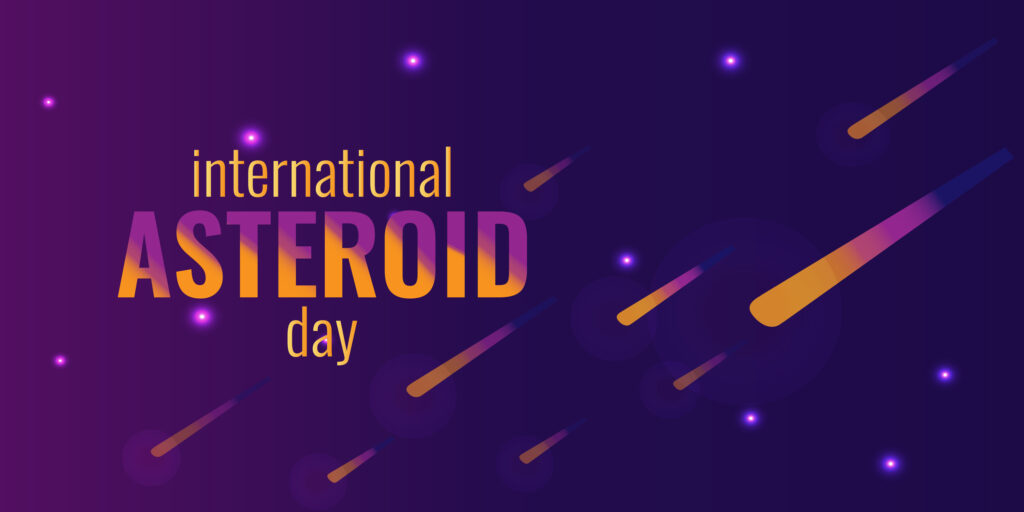Let’s Celebrate Asteroid Day

June 30 is Asteroid Day! You may be thinking– why does a rock get its own day? Or what even is an asteroid? This day isn’t only about celebrating asteroids themselves, it’s purpose is to also raise awareness of the risks of asteroid impacts.
What are Asteroids?
Asteroids are rocky objects that orbit the Sun, similar to planets, but smaller. They are made up of dust, metals, and rocks leftover from the formation of the solar system. Because of their composition, asteroids tend to be irregularly shaped with a rough surface.
There are currently more than 1.2 million known asteroids, ranging from pebble-sized to hundreds of kilometers wide, according to NASA. Most reside in the asteroid belt between Mars and Jupiter, but some asteroids can be found in the orbital paths of other planets. For this reason, it is possible for asteroids and planets to collide.
History of Asteroid Day
Asteroid Day was founded in 2014 to educate the public about the importance of protecting Earth from possible impact, as well as the role asteroids played in the formation of our solar system.
Organized by the Asteroid Foundation and designated by the United Nations, this celebration is observed annually on June 30. This date recognizes the 1908 Siberia Tunguska event – Earth’s largest modern-era asteroid impact.
To initially launch Asteroid Day, members of the asteroid community drafted the 100X Asteroid Declaration, a petition to gather support for asteroid education programs. To date, hundreds of astronauts, leaders in STEM, and other prominent individuals have signed this petition.
Impact of Asteroid Collisions
Contrary to popular belief, the chance of an asteroid wiping out the entire human species is extremely low. To determine the level of damage an asteroid will cause if it hits Earth, scientists look at characteristics such as:
- Composition of the asteroid
- Size, speed, and trajectory angle
- Shock wave power
- Location of impact

If a large asteroid were to collide with land, dust particles would flood the air and cause serious damage to the environment. If it landed in the ocean, the impact would cause tsunamis and fill the atmosphere with an excessive water vapor. This could result in landslides and mudslides. In either situation, the extra kinetic energy from the asteroid could cause global earthquakes and hurricanes. Regardless of where the asteroid lands, if large enough the impact will be devastating.
But do not fear! Just because an asteroid may be approaching Earth, it does not mean it is going to end the world for us all. Almost everyday, small fragments of asteroids called meteorites collide with Earth, but their small size and composition cause them to break up in the atmosphere, barely impacting us.
Fun Facts about Asteroids
- The name asteroid comes from the Greek word meaning “starlike”.
- Brian May, astrophysicist and lead guitarist of the rock band Queen, was one of the co-founders of Asteroid Day.
- Steven Hawking, Bill Nye, Bob Saget, Jack Black, and Ashton Kutcher are a few celebrities who have signed the 100X Asteroid Declaration.
Celebrate Asteroid Day!
To celebrate, the Asteroid Foundation is hosting multiple in-person events in Luxembourg including the Asteroid Day Space Lecture and Asteroid Day Festival, where people can come together and learn from experts. They also provide a collection of live broadcasts from previous years, along with other video resources, so people can learn from all over the world.
There’s still time to join in on the fun with events organized across 5 continents, consider joining in on the fun!
Individuals can plan their own events too, including asteroid-related contests, watching movies, learning fun facts, and playing around with asteroid impact simulators!
IEEE TryEngineering provides students and teachers with access to online resources, lesson plans, and fun activities to learn about engineering concepts. For more information about aerospace engineering and asteroids, check out TryEngineering today!
Explore more TryEngineering Resources:
Teacher Resources:
NASA: Back-to-School Resources
Student Resources:
Aerospace Engineering – Career Pathways
Why The World Celebrates Asteroid Day















